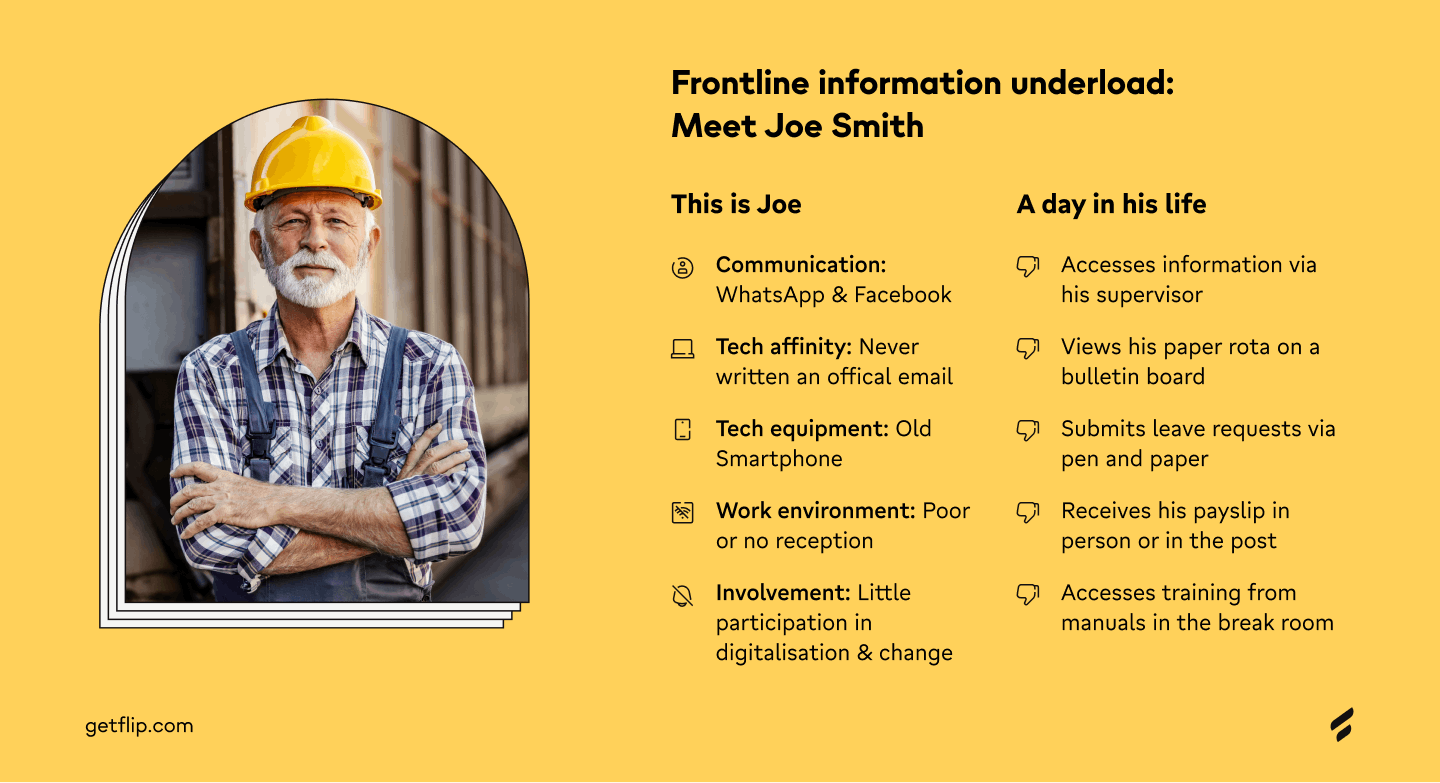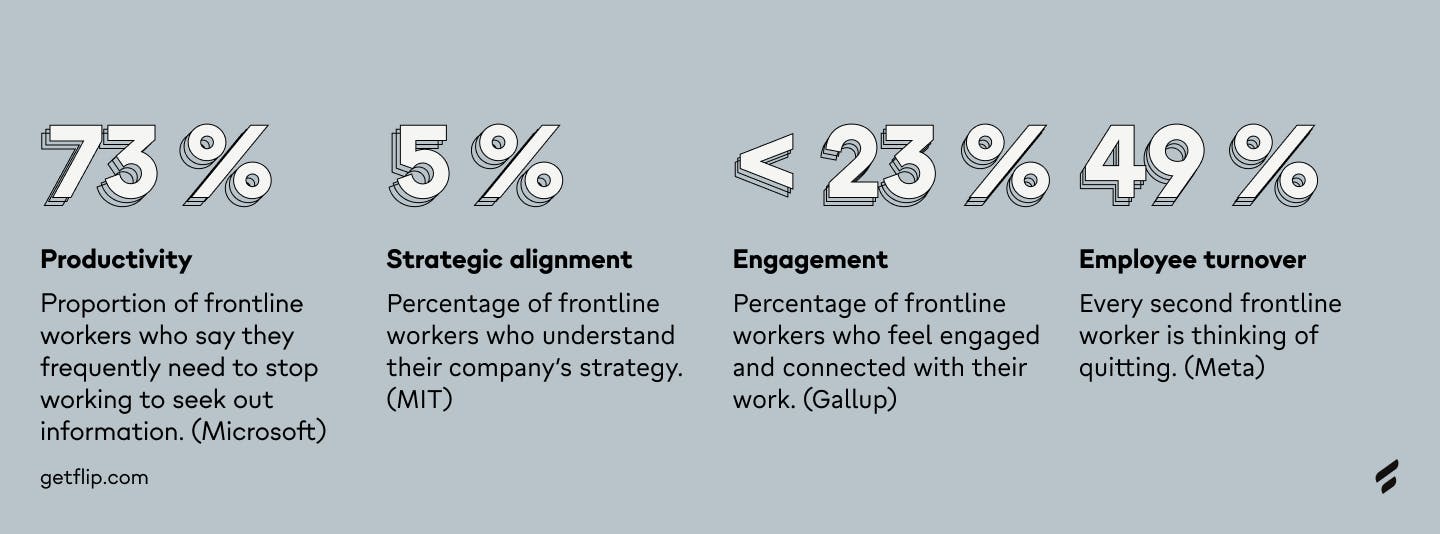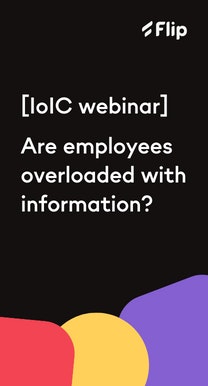Invalid date
Internal Communications
4 min read


Right message, audience, time, and channel: Segmenting your workforce for better internal comms [plus checklist!]
While knowledge workers are bombarded with company communications, frontline workers are usually left out of the loop. In this article we’ve gathered key insights and actionable advice from our recent IoIC webinar ‘Are employees being overloaded with company information?’. In it, you’ll learn the needs and challenges of different worker groups, and how to select the right channels for your employee communications.
Are employees being overloaded with company information?
That was the core question at a recent Flip webinar on IoIC’s topic of the month: information overload. For the session, Flip’s own comms whiz Regina Craja was joined by international thought leader & employee communications expert Monique Zytnik, and Accenture Global Communications lead Scott Renneburg.
Together, they examined the differing information and communication needs across the workforce; while knowledge workers are overloaded with comms, frontline workers are suffering from a lack of information.
Get their advice on how to avoid information over- and underload through better audience research, channel segmentation, and tool selection below, or skip straight to the bottom for a handy checklist!
It’s true: knowledge workers suffer from information overload
Pre-pandemic, 27% of office-based employees and 38% of managers told Gartner they received excessive communications.
During the pandemic, many organisations ‘were forced to go remote by default rather than by design.’ As a result, desk-based workers were given more digital tools to navigate.
Though the tools are designed to help us work more effectively, their introduction has a negative impact for deskless workers: The volume of communications we receive has increased. We’re even more overloaded with information. As Regina sees it, ‘we’re pretty much always “on” in the white-collar space.’
Why are knowledge workers overloaded?
Those of us behind desks are navigating multiple information and comms channels. Endless emails, Microsoft Teams pings, Slack messages, Zoom calls, the list goes on.
For Monique, it is this volume and fragmentation to blame for information overload: ‘Companies haven’t necessarily streamlined the way they use these tools.’

'When we're overloaded with communications, people are being taken away from what's really important. And that's delivering value for clients.'
Scott Renneburg
Communications Senior Manager, Accenture
The impacts of overloaded knowledge workers
The panellists noted that the costs of overloaded knowledge workers are high.
Regina points to fatigue, burnout, and distrust of leadership among the employees, and noted that this has real business impact. Simply put: ‘overloading people is expensive.’ Other impacts include:

But: For frontline workers, the challenge is information underload
While information overload presents real risks to office-based workers and their employers, these desk-based workers are often the minority of the workforce.
Employees who work ‘frontline’ or ‘deskless’ jobs, by contrast, account for the majority of employees in many verticals. These workers face the exact opposite challenge to their back office counterparts. Instead of being bombarded with communications, they’re suffering from information underload.
Why are frontline workers underinformed?
Regina says it best: frontline workers are ‘very much on the other side of the spectrum [to office-based workers]. They have no access to information, no digital tools, and they are very much reliant on managers to pass information down to them.’
To demonstrate what this looks like, let’s meet Joe:

Joe remains underinformed due to a combination of:
- Equipment and/or infrastructure limitations
- Low affinity for corporate comms channels
- Lack of frontline-appropriate tools
- Existing manual & paper-based processes
84% of deskless workers feel they’re not kept properly informed with company communications, according to research from MIT’s Center for Information Systems Research.
The impacts of an under-informed frontline workforce
While frontline staff experience the opposite problem to their office-based counterparts, the impacts are similar. Information underload also threatens productivity, strategic alignment, and retention:

With the predicted UK shortfall of 2.6 million workers by 2030, these engagement and turnover stats are especially concerning.
Combatting information over- and underload
With workers experiencing vastly different challenges when it comes to communications and comms, it follows that we need to divide and conquer.
To do so, Regina suggests a tailored approach. Or, as Scott put it, we need to ‘move away from the ethos of spraying and praying.’ He also suggested others use the guiding principle embraced by Accenture comms and ‘move away from being leader-led to audience-led.’
Understand your audience
Monique suggests some key steps to understand your audience, drawing from her 20 years of expertise in internal communications:
- Audit internal communications to find audiences you are failing to reach or engage;
- Analyse whether it is channels or messaging to blame;
- Look at recent research (e.g. from the IoIC) to understand broad-brush needs of different types of workers;
- Actually speak to your different stakeholder groups.
She underlines that last point: ‘At the end of the day, you actually have to know your target audience and their specific experiences. And the only way to do that is to talk to them.’ Setting up structured interviews or a field study, for example, will help IC understand the needs, wants, priorities, pain points, and channel preferences of different employee groups.
Understand your channels
On that last point – the pandemic period saw companies throw a lot of new channels at employees, without always considering how they will be used. Regina pointed out that regardless of how helpful they might be to office-based workers, it makes no sense to roll out Slack or Teams to the frontline.
In Monique’s view, Internal Communications needs to rationalise the ways the organisation communicates – that it’s the function’s job to ‘streamline content and comms within the organisation.’ Instead of broadening channels, Regina suggests ‘removing at least as much as you add’ – though frontline workers especially need better communications channels, that shouldn’t mean more fragmentation.
Make tailored tech choices
In Regina’s view, we’re often getting ahead of ourselves in conversations about technology – we rhapsodise about the potential of AI to ‘cut through the noise’ while failing to reach half of our workforce.

We're really in a reality where first we need to get all workers digitally connected to their companies. We need to switch from the mentality of “we want to have tools available” to “we want to make our tools work"
Regina Craja
Communications Lead, Flip
Checklist: Improve your internal comms & reach frontline employees
- Audit existing strategy to identify gaps in reach & engagement
- Analyse channels & messaging for cause
- Consult existing research & benchmarks
- Research needs, pains, and preferences of different employee groups
- Get leadership buy-in by illustrating the costs of poor communication through audit findings and stakeholder interview responses
- Select channels based on ease of use, access, and simplicity
- Embrace technology, but don’t run before you can walk
- Streamline your channels
- Segment communications by seniority, role, location, etc.
- Combine need to know info with things each audience wants to know
- Measure, analyse, review, incrementally improve

Watch the full webinar on demand
Access the full Flip <> IoIC webinar to hear even more insights from Monique, Scott, and Regina on the differing needs of office-based and frontline workers, and why Internal Communications teams need to find new ways to listen and understand their target audiences.









